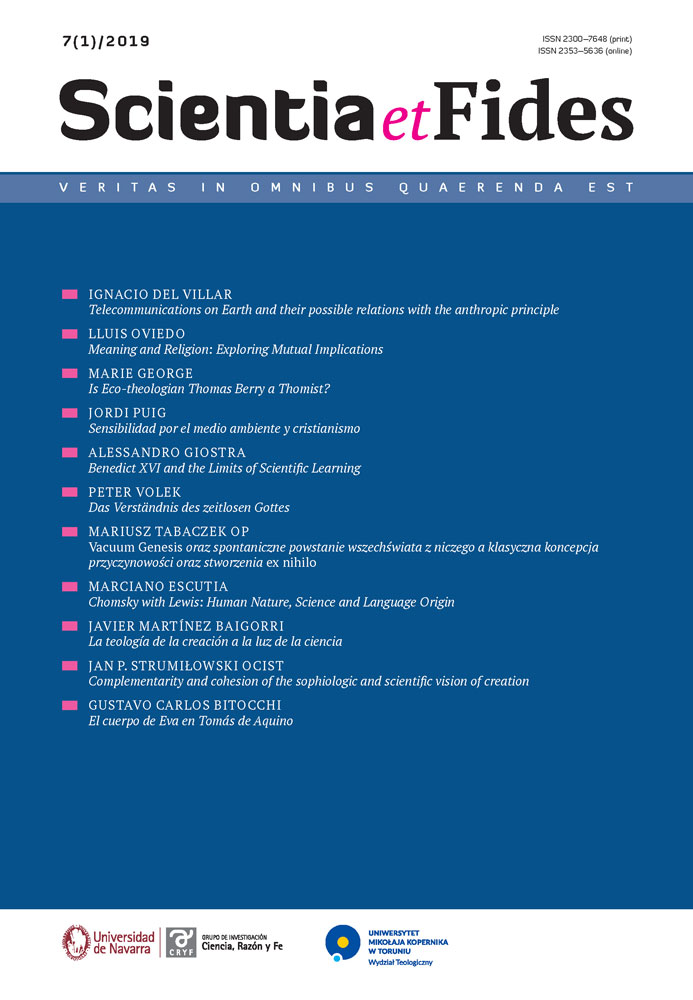El cuerpo de Eva en Tomás de Aquino
Keywords
body, matter, man, Adam, woman, feminismAbstract
The body of Eva in Thomas Aquinas
The constitution of the first female body or the body of Eva presents several physical and metaphysical problems, problems that have gone through the centuries and reach the present, generating social and cultural consequences for women. The non-existence of parents demands from Aquino answers that go beyond the anthropological and biological and lead to the search of philosophical answers intertwined with the theological ones. Thomas Aquinas provides rational answers although the background is of faith, and even, with literal interpretations of the Sacred Scriptures now abandoned. The Aquinate makes an intellectual effort to find answers in a rational field because the matter of the body of the first woman brings difficulties for its elucidation and understanding. As in other parts of his extensive work, Thomas Aquinas, follows the biological and physical works of Aristotle. Although the Aristotelian background is in line with Christian thought, Aquinas shows his extraordinary capacity for synthesis between the faith received and reason argued, between revelation (and especially the Holy Scriptures in this case) and the principles of reason.
References
Alby, Juan. 2007. “La medicina medieval y la filosofía tomista del cuerpo”. XXXII Congreso Internacional de la Sociedad Tomista Argentina: Filosofía del cuerpo: Artículo 22.
Archideo, Lila Blanca. 1991. “Bases para una antropología femenina en Santo Tomás”. Atti del IX Congresso Tomistico Internazionale: 91–104.
Archideo, Lila Blanca. 2004. “Un aporte al humanismo cristiano: la mujer y la amistad. Sus bases en Santo Tomás de Aquino”. Atti del Congresso Internazionale su l'umanesimo cristiano nel III milennio: la prospettiva di Tommaso d'Aquino: vol. 1, 287–293.
Argüello, Santiago. 2005. Posibilidad y principio de plenitud en Tomás de Aquino. Pamplona: Eunsa.
Balmaseda Cinquina, María Fernanda. 1995. “El neofeminismo y la concepción de la mujer según Santo Tomás”. Philosophica: 18, 181–201.
Gilson, Etienne. 1951. El tomismo. Introducción a la filosofía de Santo Tomás de Aquino. Buenos Aires: Desclée, de Brouwer.
Hartel, Joseph Francis. 1993. “Femina ut imago Dei, In the Integral Feminism of St. Thomas Aquinas”, Analecta Gregoriana 269, 83–89.
Horvat, Sasa. 2017. “Neuroscientific findings in the light of Aquinas'
understanding of the human being”, Scientia et Fides 2 (2017), 127–153.
Oliboni, Melissa. 1995. Anima e corpo in Tommaso d'Aquino: una rilettura. Recanati: Editore Leopardi.
Popik, Kristine Mary. 1979. The Philosophy of Woman of St. Thomas Aquinas. Rome: Ed. Pontifical University of St. Thomas Aquinas.
Rossi, Teodora. 1991. “Il corpo muliebre nell’articolo 1 della q. 92, I pars”. Studi Tomisti, 42, 105–110.
Tomás de Aquino. 1988. Suma de Teología. Madrid: Biblioteca de Autores Cristianos, 5 Tomos http://hjg.com.ar/sumat/ (31.03.13).
Tomás de Aquino. 2005. Comentario a las Sentencias de Pedro Lombardo, Libro II, La formación de la mujer, Volumen II/1 La creación: Ángeles, seres corpóreos, hombre. Pamplona: Eunsa.
Tomás de Aquino. Corpus Thomisticum. http://www.corpusthomisticum.org/ (31.03.13)
Downloads
Published
How to Cite
Issue
Section
License
CC BY ND 4.0. The Creator/Contributor is the Licensor, who grants the Licensee a non-exclusive license to use the Work on the fields indicated in the License Agreement.
- The Licensor grants the Licensee a non-exclusive license to use the Work/related rights item specified in § 1 within the following fields: a) recording of Work/related rights item; b) reproduction (multiplication) of Work/related rights item in print and digital technology (e-book, audiobook); c) placing the copies of the multiplied Work/related rights item on the market; d) entering the Work/related rights item to computer memory; e) distribution of the work in electronic version in the open access form on the basis of Creative Commons license (CC BY-ND 3.0) via the digital platform of the Nicolaus Copernicus University Press and file repository of the Nicolaus Copernicus University.
- Usage of the recorded Work by the Licensee within the above fields is not restricted by time, numbers or territory.
- The Licensor grants the license for the Work/related rights item to the Licensee free of charge and for an unspecified period of time.
FULL TEXT License Agreement
Stats
Number of views and downloads: 695
Number of citations: 1



